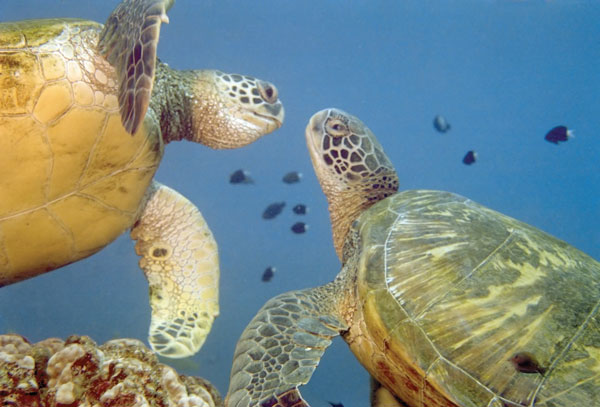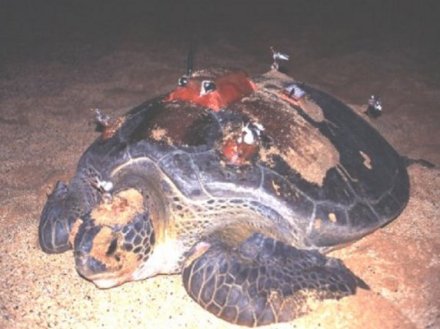
How can marine turtles or migrant birds find their home? For sure not using stars, nor GPS. Some scientists say, that using the magnetic field of Earth.
Researchers from the University of North Carolina in USA [1, 2] made marine turtles captured in Florida swim inside big coils, simulating the Earth field 337 km north or south from their native place.
Green sea-turtles, Chelonia mydas, are able to navigate accurately across vast distances. Copyright: Nature (http://www.nature.com/nature/journal/v428/n6986/fig_tab/428909a_F1.html ).
The turtles headed directly towards their imaginary home.
In the circles, each black dot represents the mean orientation
angle of one turtle. The arrow in the centre of each circle indicates the mean
angle of the group; arrow length is proportional to the magnitude of the mean
vector r; circle radius corresponds to r
= 1. In a 'northern' field (inclination: 61.2°, total intensity: 49.3 ![]() T;
upper diagram), turtles were significantly oriented (r
= 0.70, P = 0.003, Rayleigh test) with a mean angle
of 171.7°. In a 'southern' field (inclination: 55.4°, total intensity: 45.4
T;
upper diagram), turtles were significantly oriented (r
= 0.70, P = 0.003, Rayleigh test) with a mean angle
of 171.7°. In a 'southern' field (inclination: 55.4°, total intensity: 45.4 ![]() T;
lower diagram), turtles were significantly oriented (r
= 0.54, P = 0.027) with a mean angle of 15.8°.
Dashed lines represent the 95% confidence interval for the mean angle. Data are
plotted relative to magnetic north. Tests were done between 12:00 and 18:00
hours under diverse weather conditions. Map scale bar, 100 km. Copyright: Nature (http://www.nature.com/nature/journal/v428/n6986/fig_tab/428909a_F2.html).
T;
lower diagram), turtles were significantly oriented (r
= 0.54, P = 0.027) with a mean angle of 15.8°.
Dashed lines represent the 95% confidence interval for the mean angle. Data are
plotted relative to magnetic north. Tests were done between 12:00 and 18:00
hours under diverse weather conditions. Map scale bar, 100 km. Copyright: Nature (http://www.nature.com/nature/journal/v428/n6986/fig_tab/428909a_F2.html).
Researchers from Pisa, Italy, made Brazilian turtles swim with permanent magnets attached to the shells. This hampered the turtles to use the Earth magnetic field compass.

Turtle with attached permanent magnets. Copyright: Universita di Pisa (http://www.deee.unipi.it/islameta/Research/Sea%20Turtle%20Navigation/Magnet%20photo.jpg).
But turtles, smartly, found their route back to the Brazilian coast.
Routes of turtles. Copyright: Universita di Pisa (http://www.deee.unipi.it/islameta/Research/Sea%20Turtle%20Navigation/Routes%20from%20Ascension.jpg).
Swedish scientists studied thrush nightingales (Luscinia luscinia) migrating to Africa. These birds stop in Egypt, to store fat reserves, before crossing Sahara desert.
Nightdale, Poland
Hear "Słowik szary" © Soliton, Sopot
The scientists subjected young birds, caught in Sweden, to the magnetic field as that in Egypt. Nightingales grew in fat.
a, Map showing the points of autumn
recovery of migrating birds originally ringed in Sweden (n
= 9) and the stopover sites for which magnetic fields were simulated (total
intensity (values in nanotesla) and inclination). b,
Average body-mass increase (![]() s.e.) during the experiment (registered automatically using a Precisa Balance
310C). The field experienced by experimental birds was changed to that of four
localities during the course of the experiment, calculated according to IGRF2000
(ref. 12). Experimental birds remained from day 7 in the magnetic field of
northern Egypt until the end of the experiment at day 11, when all birds were
released back into the wild. The magnetic system consisted of two independent
series of four quadratic coils each, arranged orthogonally13.
We verified the homogeneity of the magnetic field and set the vertical and
horizontal components for the stopover sites using a Zeiss Jena theodolite with
a fluxgate magnetometer (Bartington Instruments) and a proton magnetometer (GEM
Systems). Further details are available from the authors. Copyright: Nature (http://www.nature.com/nature/journal/v414/n6859/fig_tab/414035a0_F1.html).
s.e.) during the experiment (registered automatically using a Precisa Balance
310C). The field experienced by experimental birds was changed to that of four
localities during the course of the experiment, calculated according to IGRF2000
(ref. 12). Experimental birds remained from day 7 in the magnetic field of
northern Egypt until the end of the experiment at day 11, when all birds were
released back into the wild. The magnetic system consisted of two independent
series of four quadratic coils each, arranged orthogonally13.
We verified the homogeneity of the magnetic field and set the vertical and
horizontal components for the stopover sites using a Zeiss Jena theodolite with
a fluxgate magnetometer (Bartington Instruments) and a proton magnetometer (GEM
Systems). Further details are available from the authors. Copyright: Nature (http://www.nature.com/nature/journal/v414/n6859/fig_tab/414035a0_F1.html).
So, some turtles follow the magnetic field, other do not confused with magnets attached. Results are far from being conclusive [5].
We highly acknowledge pictures from "Nature" © Nature Publishing Group
and correspondence with dr Paolo Luschi.
Read more:
● Turtle research
The University of North Carolina University at Chapel Hill
http://www.unc.edu/depts/oceanweb/turtles/
● Orientation, Homing, and Navigation in Spiny Lobsters
The University of North Carolina University at Chapel Hill
http://www.unc.edu/depts/oceanweb/lobsters/
● Magnetic experiments with migrating Ascension turtles
Universitą di Pisa, Dipartimento di Etologia, Ecologia, Evoluzione
http://www.deee.unipi.it/islameta/Sea%20Turtle%20Navigation.html
References:
[1] Animal behaviour: Geomagnetic map used in sea-turtle navigation
Kenneth J. Lohmann, Catherine M. F. Lohmann, Llewellyn M. Ehrhart, Dean A. Bagley and Timothy Swing, Nature 428, 909-910 (29 April 2004) | doi: 10.1038/428909a
http://www.nature.com/nature/journal/v428/n6986/full/428909a.html
[2] Regional Magnetic Fields as Navigational Markers for Sea Turtles
Kenneth J. Lohmann, Shaun D. Cain, Susan A. Dodge, and Catherine M. F. Lohmann
Science 12 October 2001: 364-366
http://www.sciencemag.org/cgi/content/full/294/5541/283a
[3] Papi, F., Luschi, P., Akesson, S., Capogrossi, S., & Hays, G.C. (2000). Open-sea migration of magnetically disturbed sea turtles. J. Exp. Biol. 203, 3435-3443.
Read a comment by Dr Paolo Luschi, Pisa University
(it)![]()
[4] Bird migration: Magnetic cues trigger extensive refuelling
Thord Fransson, Sven Jakobsson, Patrik Johansson, Cecilia Kullberg, Johan Lind and Adrian Tallin, Nature 414, 35-36 (1 November 2001) | doi: 10.1038/35102115
http://www.nature.com/nature/journal/v414/n6859/full/414035a0.html
[5] T. Alerstam, Conflicting Evidence About Long-Distance Animal Navigation, Science, Vol. 313, 11 August 2006, p. 792